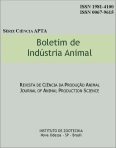Physico-chemical composition of Apis mellifera L. honey samples of the state of Tocantins, Brazil
Keywords:
Apis mellifera, cluster analysis, physico-chemical analysis, pollen types, TocantinsAbstract
This paper was carried out to determine how can be grouped the Apis mellifera honey samples of the State of Tocantins, Brazil, with base to physico-chemical composition of honey. The samples were collected in different municipalities. Among the 21 honey samples analyzed it was observed that the ones which have Mimosa scabrella, Caesalpinia sp and Arecaceae type ones as dominant or accessory pollen, form different groups or sub-groups based on the physicochemical parameters. The results confirm that the honey bee composition is influenced its origin nectar. The grouping of the honey samples was mostly influenced by viscosity and pH in the X axle, and acidity and reducing sugars, in the Y axle.
Downloads
Downloads
Published
Issue
Section
License
Os autores não serão remunerados pela publicação de trabalhos, pois devem abrir mão de seus direitos autorais em favor deste periódico. Por outro lado, os autores ficam autorizados a publicar seus artigos, simultaneamente, em repositórios da instituição de sua origem, desde que citada a fonte da publicação original seja Boletim de Indústria Animal. A revista se reserva o direito de efetuar, nos originais, alterações de ordem normativa, ortográfica e gramatical, com vistas a manter o padrão culto da língua e a credibilidade do veículo. Respeitará, no entanto, o estilo de escrever dos autores. Alterações, correções ou sugestões de ordem conceitual serão encaminhadas aos autores, quando necessário. Nesses casos, os artigos, depois de adequados, deverão ser submetidos a nova apreciação. As opiniões emitidas pelos autores dos artigos são de sua exclusiva responsabilidade. Todo o conteúdo deste periódico, exceto onde está identificado, está licenciado sob a Licença Creative Commons Attribution (CC-BY-NC). A condição BY implica que os licenciados podem copiar, distribuir, exibir e executar a obra e fazer trabalhos derivados com base em que só se dão o autor ou licenciante os créditos na forma especificada por estes. A cláusula NC significa que os licenciados podem copiar, distribuir, exibir e executar a obra e fazer trabalhos derivados com base apenas para fins não comerciais.













